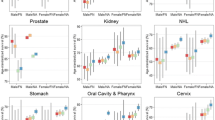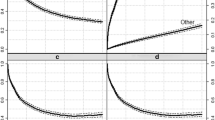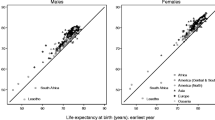Abstract
Objectives: Cancer survival information is available only in areas covered by cancer registration. The objective of this study is to project cancer survival for the entire US as well as states from survival data from the National Cancer Institute's Surveillance, Epidemiology, and End Results (SEER) program. Methods: Five-year breast, prostate, and colorectal cancer relative survival rates from SEER are regressed on socioeconomic, demographic, and health variables at the county level. These models are first validated by comparing the observed rates with projected rates for counties not used in the estimation process. Results: Education was the best indicator of longer cancer survival. Other important predictors of the geographical variability of survival varied by cancer site. Better survival was predicted for breast and prostate than for colorectal cancer. Conclusions: Data from cancer registries can be used in ecological models to provide national and state estimates of patients' survival rates. These estimates are useful in targeting areas in which to promote earlier diagnosis or improved access to care, and may also aid in monitoring the quality of survival data collected by individual cancer registries.
Similar content being viewed by others
References
Surveillance, Epidemiology, and End Results (SEER) Program Public-Use CD-ROM (1973–1997) National Cancer Institute, DCCPS, Cancer Surveillance Research Program, Cancer Statistics Branch, releasedApril 2000, based on the August 1999 submission.
Frey CM, McMillen MM, Cowan CD, Horm JW, Kessler LG (1992) Representativeness of Surveillance, Epidemiology and End Results Program data: recent trends in cancer mortality rates. J Natl Cancer Inst 84: 872–877.
Frey CM, Feuer EJ, Timmel MJ (1994) Projection of incidence rates to a larger population using ecologic variables. Stat Med 13: 1755–1770.
Verdecchia A, Capocaccia R, Egidi V, Golini A (1989) A method for the estimation of chronic disease morbidity and trends from mortality data. Stat Med 8: 201–216.
Swan J, Wingo P, Clive R, et al. (1998) Cancer surveillance in the US: can we have a national system? Cancer 83: 1282–1291.
Chen VW, Howe HL, Xu XC, Hotes JL, Correa CN (eds). (2000) Cancer in NorthAmerica, 1993–1997, vol. 1: Incidence. Springfield, IL: North American Association of Central Cancer Registries, April.
Area Resource File (1997) Office of Research and Planning, Bureau of Health Professionals.
Cella DF, Orav EJ, Kornbith AB, et al. (1991) Socioeconomic status and cancer survival. J Clin Oncol 9: 1500–1509.
Wells BL, Horm JW (1998) Targeting the underserved for breast and cervical cancer screening: the utility of ecological analysis using the National Health Interview Survey. Am J Public Health 88: 1484–1489.
Breen N, Figueroa JB (1996) Stage of breast and cervical cancer diagnosis in disadvantage neighborhoods: a prevention policy perspective. Am J Prev Med 12: 319–326.
Bassett MT, Krieger N (1986) Social class and black-white differences in breast cancer survival. Am J Public Health 76: 1440–1403.
Ederer F, Axtell LM, Cutler SJ (1961) The relative survival rate: a statistical methodology. Natl Cancer Inst Monogr 6: 101–121.
Hakulinen T, Tenkanen L (1987) Regression analysis of relative survival rates. Roy Stat Soc 36: 309–317.
McCullagh P, Nelder JA (1989) Generalized Linear Models. London: Chapman & Hall, pp. 124–128.
Kendall M, Stuart A (1977) The Advanced Theory of Statistics, vol. I, 4th ed. London: Charles Griffin, pp. 246–248.
Gatta G, Capocaccia R, et al. (2001) Comparison of the survival in American and European cancer patients diagnosed in the late eighties. (In preparation).
Berrino F, Sant M, Verdecchia A, et al., eds. (1995) Survival of Cancer Patients in Europe: the EUROCARE Study. Lyon: IARC Scientific Publications no. 132.
Sant M and the EUROCARE Working Group (1999) Overview of the EUROCARE-2 results on survival of cancer patients diagnosed in 1985-89. In: Berrino F, Capocaccia R, Estève J, Gatta G, Hakulinen T, Micheli A, Sant M, Verdecchia A, eds. Survival of Cancer Patients in Europe: the EUROCARE-2 Study. Lyon: IARC Scientific Publications no. 151, pp. 525–541.
Coleman MP, Babb P, Damiecki P, et al. (1999) Cancer survival trends in England and Wales, 1971–1995: deprivation and NHS region. Studies in Medical and Population Subjects, 60: London: HMSO.
Gatta G, Buiatti E, Conti E, et al. (1997) Variations in the survival of adult cancer patients in Italy. In: Verdecchia A, Micheli A, Gatta G (1997) Survival in cancer patients in Italy: the ITACARE study. Tumori 83: 497–507.
Author information
Authors and Affiliations
Rights and permissions
About this article
Cite this article
Mariotto, A., Capocaccia, R., Verdecchia, A. et al. Projecting SEER cancer survival rates to the US: an ecological regression approach. Cancer Causes Control 13, 101–111 (2002). https://doi.org/10.1023/A:1014380323037
Issue Date:
DOI: https://doi.org/10.1023/A:1014380323037




